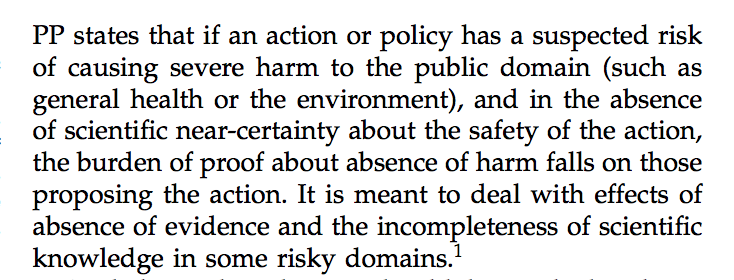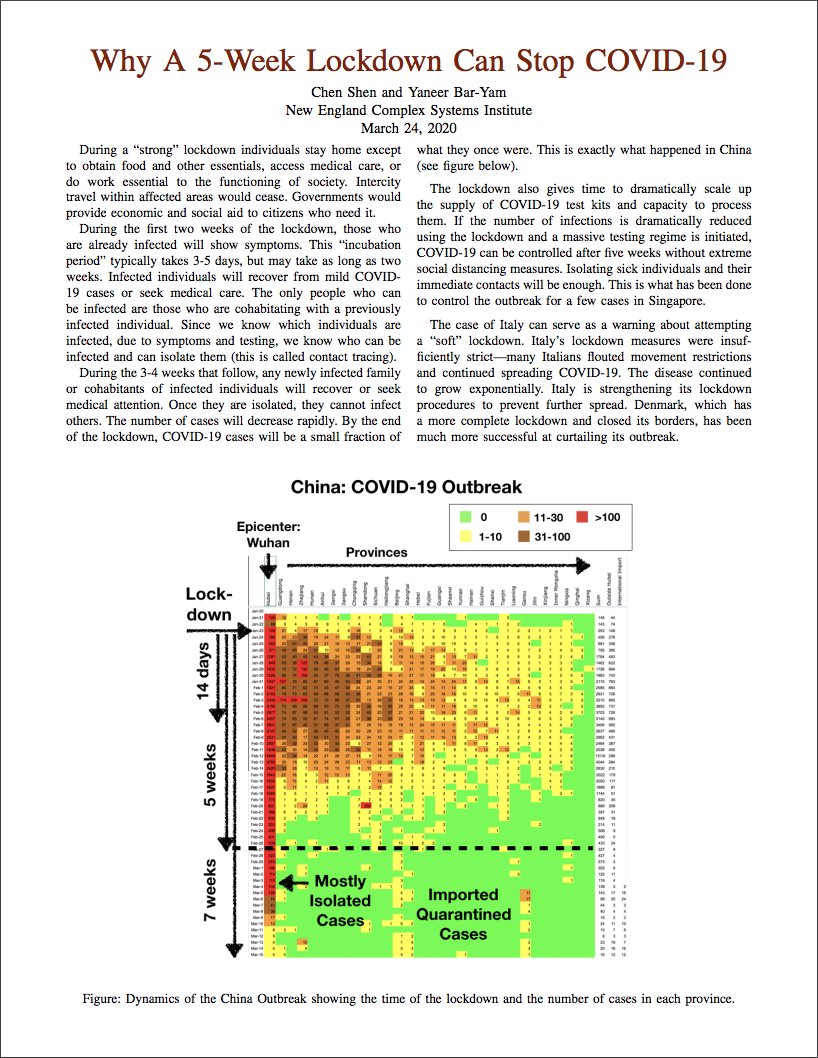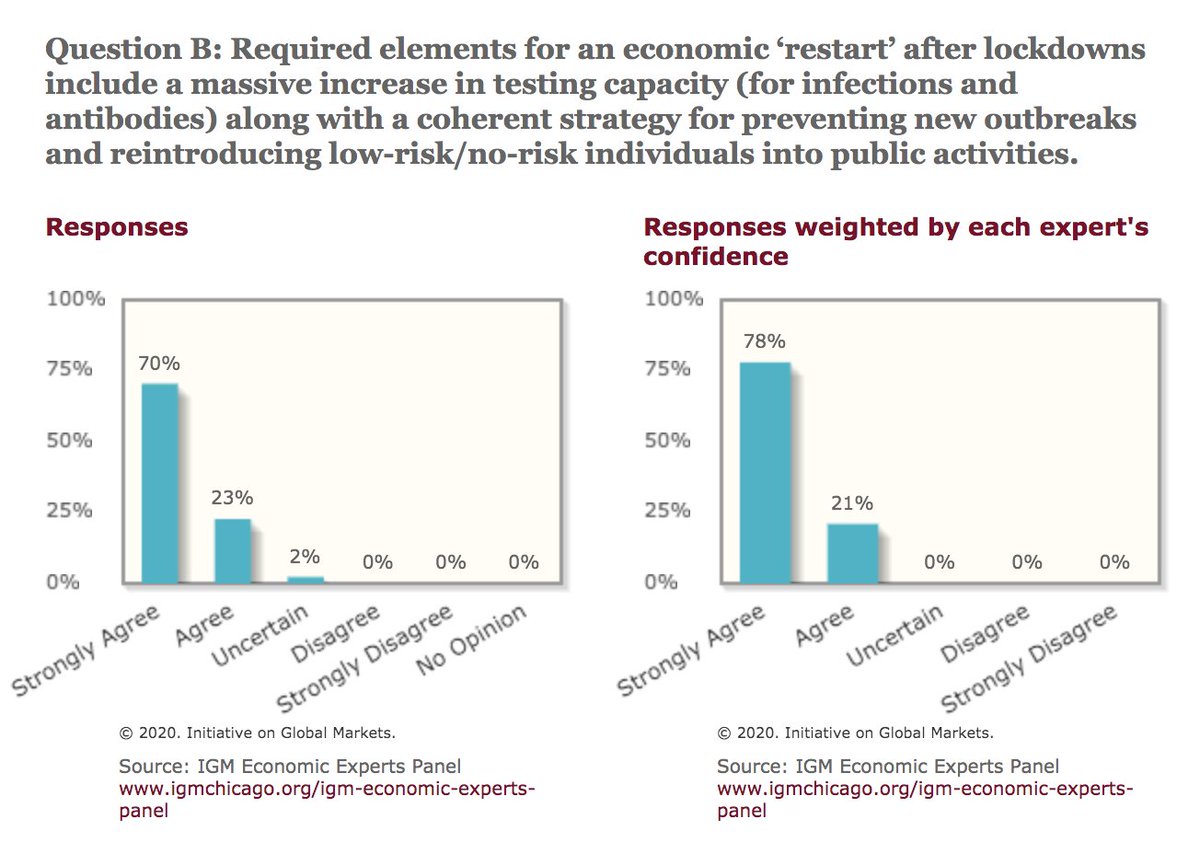Below is a thread on why lockdowns need not be "economic suicide" as Steve Waterson described them in a recent article ( https://www.theaustralian.com.au/inquirer/national-coronavirus-hysteria-will-lead-to-disproportionate-suffering/news-story/56f887b32023c30efcc5f51346c92051).
I& #39;m">https://www.theaustralian.com.au/inquirer/... no expert, merely synthesizing what I& #39;ve learned. If errors exist, they are mine and I would love for you to point them out. 1/
I& #39;m">https://www.theaustralian.com.au/inquirer/... no expert, merely synthesizing what I& #39;ve learned. If errors exist, they are mine and I would love for you to point them out. 1/
I& #39;m going to focus on Australia. Australia is not under a national lockdown. Rather, we have a collection of state-based lockdowns (pictured below; source: The Australian), which emerged in a piecemeal fashion through mid-to-late March 2020, with Federal backing. 2/
Since 31 March, Australian states have enforced "stage three" lockdowns.
(It& #39;s unclear exactly what stage four would entail, but New Zealand& #39;s "Alert Level 4" may provide clues. Here you can find an exhaustive list of "essential" businesses in NZ: https://covid19.govt.nz/businesses-and-employees/essential-businesses/)">https://covid19.govt.nz/businesse... 3/
(It& #39;s unclear exactly what stage four would entail, but New Zealand& #39;s "Alert Level 4" may provide clues. Here you can find an exhaustive list of "essential" businesses in NZ: https://covid19.govt.nz/businesses-and-employees/essential-businesses/)">https://covid19.govt.nz/businesse... 3/
@ScottMorrisonMP has insisted that Australians should be prepared "to completely change the way they are going to live for the next six months at least."
Understandably, the prospect of months-long lockdowns has sparked strong intellectual and emotional resistance. 4/
Understandably, the prospect of months-long lockdowns has sparked strong intellectual and emotional resistance. 4/
Most skeptics, like Steve Waterson, justifiably fear the iatrogenic harm lockdowns might inflict on the economy. Others reasonably chafe at the squashing of liberty.
Here are a few other people who have recently raised concerns over lockdowns: 5/
Here are a few other people who have recently raised concerns over lockdowns: 5/
- Tom Switzer: "The problem for western governments is they have drawn up a template for dealing with a pandemic that focuses on saving life first and saving the economy later." ( https://www.smh.com.au/national/our-liberty-and-prosperity-are-in-peril-if-covid-19-triggers-an-arms-race-of-compassion-20200403-p54gqc.html)">https://www.smh.com.au/national/... 6/
- @AlexanderDowner: "We either save avoidable deaths & destroy society OR accept avoidable deaths & save society. The moral dilemma of our time." ( https://twitter.com/AlexanderDowner/status/1247498933842018305?s=20)">https://twitter.com/Alexander... 7/
- @Adam_Creighton: "Concerns about the economy are dismissed as heartless but the downsides of prolonged recession are very human." ( https://www.theaustralian.com.au/business/economics/coronavirus-total-shutdown-may-be-too-high-a-price/news-story/6a857afea1357d470a88671e2e171a58)">https://www.theaustralian.com.au/business/... 8/
Crucially, I& #39;m going to assume that concerns over lockdowns are predicated not on their severity but *duration*.
I& #39;ll return to the question of duration. Now let& #39;s examine some specific objections to lockdowns. The weaker objections point to how few deaths we& #39;ve seen so far. 9/
I& #39;ll return to the question of duration. Now let& #39;s examine some specific objections to lockdowns. The weaker objections point to how few deaths we& #39;ve seen so far. 9/
Waterson: "[W]hen did life move from being precious to priceless? We lost 20 people to the disease in March. In the same month we lost another 13,000 or so to other ailments and accidents, but let’s not worry about them." 10/
@Adam_Creighton: "COVID-19 is clearly much more serious [than Asian bird flu or mad cow disease], having already killed about 70,000 people, but the toll is still a long way short of predictions of over 100,000 dead here, and tens of millions globally." 11/
11/ The issue with these objections is: what happens in equilibrium doesn& #39;t tell us what happens out of equilibrium.
The fact that absolute deaths are low doesn& #39;t obviate countermeasures; it is because of countermeasures.
@profholden explains here: https://theconversation.com/vital-signs-a-lesson-from-game-theory-the-coronavirus-contrarians-ignore-135821">https://theconversation.com/vital-sig... 12/
The fact that absolute deaths are low doesn& #39;t obviate countermeasures; it is because of countermeasures.
@profholden explains here: https://theconversation.com/vital-signs-a-lesson-from-game-theory-the-coronavirus-contrarians-ignore-135821">https://theconversation.com/vital-sig... 12/
More sophisticated critiques attempt a cost/benefit analysis. Several economists -- some for lockdowns, others against -- have offered their own analyses:
- @FrijtersPaul (against): http://clubtroppo.com.au/2020/03/21/the-corona-dilemma/">https://clubtroppo.com.au/2020/03/2... & http://clubtroppo.com.au/2020/04/08/how-many-wellbys-is-the-corona-panic-costing/
-">https://clubtroppo.com.au/2020/04/0... @zingales (for): https://promarket.org/captured-western-governments-are-failing-the-coronavirus-test/">https://promarket.org/captured-... 13/
- @FrijtersPaul (against): http://clubtroppo.com.au/2020/03/21/the-corona-dilemma/">https://clubtroppo.com.au/2020/03/2... & http://clubtroppo.com.au/2020/04/08/how-many-wellbys-is-the-corona-panic-costing/
-">https://clubtroppo.com.au/2020/04/0... @zingales (for): https://promarket.org/captured-western-governments-are-failing-the-coronavirus-test/">https://promarket.org/captured-... 13/
- @jasemurphy (for) and @DrCameronMurray (against): https://twitter.com/jasemurphy/status/1246644434629877760?s=20
-">https://twitter.com/jasemurph... Sam Lovick (against): https://www.afr.com/policy/health-and-education/we-could-be-saving-lives-for-less-than-6m-each-20200406-p54hie">https://www.afr.com/policy/he... 14/
-">https://twitter.com/jasemurph... Sam Lovick (against): https://www.afr.com/policy/health-and-education/we-could-be-saving-lives-for-less-than-6m-each-20200406-p54hie">https://www.afr.com/policy/he... 14/
Moral philosophers @PeterSinger and @MichaelDPlant have broadly supported the use of cost/benefit analyses in weighing responses to the pandemic, arguing that wellbeing should be their common currency ( https://www.project-syndicate.org/commentary/when-will-lockdowns-be-worse-than-covid19-by-peter-singer-and-michael-plant-2020-04).">https://www.project-syndicate.org/commentar... 15/
I& #39;ll leave to one side the traditional problem with cost/benefit analyses -- that they fail to quantify many important things (as @EconTalker notes in this podcast: https://review.chicagobooth.edu/economics/2020/article/capitalisn-t-coronavirus-cost-benefit-analysis-economic-shutdown)">https://review.chicagobooth.edu/economics... -- as this problem cuts both ways and I don& #39;t know how to resolve it. Instead... 16/
Insofar as cost/benefit analyses are used to oppose lockdowns, I& #39;ll give three stylized responses:
i) lockdowns don& #39;t cause recessions, the virus does; ii) lockdowns are necessitated by the Precautionary Principle; iii) lockdowns don& #39;t need to be as costly as opponents think. 17/
i) lockdowns don& #39;t cause recessions, the virus does; ii) lockdowns are necessitated by the Precautionary Principle; iii) lockdowns don& #39;t need to be as costly as opponents think. 17/
First, proponents of what I& #39;ll call the "laissez-faire" view (herd immunity as a strategy but with some countermeasures to disperse the burden on hospitals; sometimes called "mitigation") frame lockdowns as choosing health over the economy. I think this is a false dichotomy. 18/
The real counterfactual to top-down lockdowns isn& #39;t that people go about their lives as normal; it& #39;s bottom-up lockdowns. As @LHSummers put it: "we would all be social distancing out of fear, not because of a law." ( https://www.wired.com/story/rush-back-to-normal-blunder-of-the-century/)">https://www.wired.com/story/rus... 19/
To illustrate, look at the OpenTable data for Australian restaurants. Bookings were already down every day YoY in the three weeks prior to midday 23 March when restaurants were shut down (image goes back two weeks, but full data can be found here: https://www.opentable.com/state-of-industry).">https://www.opentable.com/state-of-... 20/
COVID-19 is not "just a flu". In Germany and South Korea, two countries where denominators are not massively deflated and where there& #39;s high hospital capacity, CFRs have been inching upward as time passes, to 1.8% and 1.93% respectively. 21/
In Australia, the CFR remains relatively low at 0.76%. I wouldn& #39;t be surprised if it remained low at the end of the pandemic (cf. https://twitter.com/threader_app/status/1247743744700366853).">https://twitter.com/threader_... But all that& #39;s needed for bottom-up economic disruption is uncertainty and fear about the CFR. 22/
I find it implausible that the working-age population would wholly buy the "just a flu" narrative because COVID-19 appears to have a higher mortality rate than the flu for them too. 23/
More likely than an indefinite bottom-up lockdown, mounting deaths would become so politically unpalatable that governments would eventually be forced to introduce top-down lockdowns. So why wait? 24/
My second response to cost/benefit analyses invokes the Precautionary Principle (PP).
To quote @normonics: "All our assumptions are potential liabilities." 25/
To quote @normonics: "All our assumptions are potential liabilities." 25/
It is appropriate to apply the PP here because the pandemic poses global and irreversible harm. Recall that we have no longitudinal data on COVID-19.
(SARS-CoV-2 is analogous to GMOs in this paper: https://www.fooledbyrandomness.com/pp2.pdf )">https://www.fooledbyrandomness.com/pp2.pdf&q... 26/
(SARS-CoV-2 is analogous to GMOs in this paper: https://www.fooledbyrandomness.com/pp2.pdf )">https://www.fooledbyrandomness.com/pp2.pdf&q... 26/
Here I would drop @nntaleb& #39;s quip that you would rather mistake a rock for a bear than vice versa.
Of course, as @mlipsitch recently remarked, "the dilemma of public health is the more it does its job, the more it seems like it& #39;s overreacted." ( https://www.npr.org/2020/04/03/826945368/how-the-united-states-failed-to-see-the-coronavirus-crisis-coming).">https://www.npr.org/2020/04/0... 27/
Of course, as @mlipsitch recently remarked, "the dilemma of public health is the more it does its job, the more it seems like it& #39;s overreacted." ( https://www.npr.org/2020/04/03/826945368/how-the-united-states-failed-to-see-the-coronavirus-crisis-coming).">https://www.npr.org/2020/04/0... 27/
There is no bright line between "public health" and "the economy". As @EconTalker has pointed out, both support the same end: human flourishing. 28/
You can& #39;t flourish if you& #39;re sick or dead. But broken dreams, social dysfunction, and unwanted idleness cripple our ability to flourish too. 29/
I am deeply uneasy about the idea of months-long lockdowns. Does the PP cut both ways? I don& #39;t think it does (impacts of any one country& #39;s lockdown are inherently localized and "reversible"). But the costs of lockdowns are potentially so big we should try to cauterize them. 30/
Fortunately, lockdowns done properly can be over in weeks, not months, bringing me to my third response.
"Properly" means five things: early, hard, nation-wide (if not national), fiscally-complemented, and with an exit strategy.
(In the chart below, 5 weeks is from Today.) 31/
"Properly" means five things: early, hard, nation-wide (if not national), fiscally-complemented, and with an exit strategy.
(In the chart below, 5 weeks is from Today.) 31/
In this note, @yaneerbaryam explains how a 5-week lockdown is enough to stop the spread of coronavirus:
( https://static1.squarespace.com/static/5e7b914b3b5f9a42199b3337/t/5e7bae70ed03c045bb9f7bab/1585163896267/5weeks.pdf)">https://static1.squarespace.com/static/5e... 32/
( https://static1.squarespace.com/static/5e7b914b3b5f9a42199b3337/t/5e7bae70ed03c045bb9f7bab/1585163896267/5weeks.pdf)">https://static1.squarespace.com/static/5e... 32/
It should be noted Australia is successfully flattening the curve. @CollignonPeter argues that because daily new infections peaked at about 25 March, the countermeasures implemented 5-10 days before the peak -- i.e. well before "level three" lockdowns -- must be effective. 33/
However it& #39;s probably also true that moving harder and earlier would have enabled lockdowns to be shorter and less costly. It is unclear how long Australia& #39;s current slightly-less-than-full lockdowns will be in place. 35/
Public calls for hard lockdowns were made early in Australia.
- On 9 March, on my podcast, @yaneerbaryam advocated a 4-week (two 14-day incubation cycles) lockdown for Australia: https://twitter.com/JosephNWalker/status/1236927375889199105?s=20">https://twitter.com/JosephNWa... 36/
- On 9 March, on my podcast, @yaneerbaryam advocated a 4-week (two 14-day incubation cycles) lockdown for Australia: https://twitter.com/JosephNWalker/status/1236927375889199105?s=20">https://twitter.com/JosephNWa... 36/
- On 10 March, @profholden called for Australia to shut down its borders and schools for one month: https://www.afr.com/policy/economy/why-australia-should-close-borders-schools-20200309-p5486r">https://www.afr.com/policy/ec...
- On 20 March, @JohnDaley_ proposed an eight to twelve week lockdown for Australia: https://theconversation.com/the-case-for-endgame-c-stop-almost-everything-restart-when-coronavirus-is-gone-134232">https://theconversation.com/the-case-... 37/
- On 20 March, @JohnDaley_ proposed an eight to twelve week lockdown for Australia: https://theconversation.com/the-case-for-endgame-c-stop-almost-everything-restart-when-coronavirus-is-gone-134232">https://theconversation.com/the-case-... 37/
Early, hard lockdowns can be short lockdowns. But to limit the excess economic damage, the economy needs "life support" while in its "coronacoma".
@paulkrugman explains the economics better than I can: https://www.gc.cuny.edu/CUNY_GC/media/LISCenter/pkrugman/Notes-on-Coronacoma-Economics.pdf">https://www.gc.cuny.edu/CUNY_GC/m... 38/
@paulkrugman explains the economics better than I can: https://www.gc.cuny.edu/CUNY_GC/media/LISCenter/pkrugman/Notes-on-Coronacoma-Economics.pdf">https://www.gc.cuny.edu/CUNY_GC/m... 38/
Australia& #39;s JobKeeper package is solid, notwithstanding some design quirks that should be fixed. @chrisedmond and @SHamiltonian explained these to me in this podcast:
https://twitter.com/JosephNWalker/status/1245490650545410049?s=20.">https://twitter.com/JosephNWa... 39/
https://twitter.com/JosephNWalker/status/1245490650545410049?s=20.">https://twitter.com/JosephNWa... 39/
Generous fiscal support that aims to keep employees attached to their employers enhances the economy& #39;s ability to be like "Sleeping Beauty" at the end of the lockdown. 40/
Finally, proponents of the laissez-faire approach say "the people deserve policies that work for longer than a month." ( https://www.spectator.co.uk/article/no-lockdown-please-w-re-swedish)">https://www.spectator.co.uk/article/n... They argue that lockdowns delay the inevitable. But lockdowns never meant to be the end game. 41/
Lockdowns have two purposes: i) buy you time to ramp up post-lockdown capabilities, and ii) get your caseload down so that testing and contact tracing are effective. 42/
There are two broad aspects with respect to a lockdown exit strategy: i) how to lift existing lockdown measures and ii) what to replace them with. 43/
Countermeasures should probably be lifted incrementally; for example, maintaining a ban on large events.
@yaneerbaryam also recommends zoning ( https://necsi.edu/color-zone-pandemic-response-version-2).">https://necsi.edu/color-zon...
There will be devilish details. @ZacGross identifies one example here: https://twitter.com/ZacGross/status/1247805264943710209?s=20">https://twitter.com/ZacGross/... 44/
@yaneerbaryam also recommends zoning ( https://necsi.edu/color-zone-pandemic-response-version-2).">https://necsi.edu/color-zon...
There will be devilish details. @ZacGross identifies one example here: https://twitter.com/ZacGross/status/1247805264943710209?s=20">https://twitter.com/ZacGross/... 44/
Lockdowns then need to be gradually replaced with something broadly similar to the South Korean approach of mass asymptomatic testing, contact tracing and quarantining. 45/
@John_Hempton sketches some successful approaches here: https://brontecapital.blogspot.com/2020/03/coronavirus-getting-angry.html?spref=tw
My">https://brontecapital.blogspot.com/2020/03/c... podcast with Italian Professor Andrea Crisanti, who was part of the team that led the successful experiment at Vo, adds credibility to the South Korean approach:
https://twitter.com/JosephNWalker/status/1242711330617823232?s=20">https://twitter.com/JosephNWa... 46/
My">https://brontecapital.blogspot.com/2020/03/c... podcast with Italian Professor Andrea Crisanti, who was part of the team that led the successful experiment at Vo, adds credibility to the South Korean approach:
https://twitter.com/JosephNWalker/status/1242711330617823232?s=20">https://twitter.com/JosephNWa... 46/
An overwhelming consensus of economists agrees with these principles for an exit strategy.
( http://www.igmchicago.org/igm-economic-experts-panel/)
47/">https://www.igmchicago.org/igm-econo...
( http://www.igmchicago.org/igm-economic-experts-panel/)
47/">https://www.igmchicago.org/igm-econo...
Australia needs to direct sufficient resources to build up our testing, contact tracing and quarantining capabilities. We need wartime-like efforts, an epidemiological Manhattan Project.
Lockdowns need not destroy the economy. 48/
Lockdowns need not destroy the economy. 48/
In my sleeplessness I forgot to add masks: everyone wear masks. 49/
https://twitter.com/josephnwalker/status/1243467110157676544?s=21">https://twitter.com/josephnwa... https://twitter.com/josephnwalker/status/1243467110157676544">https://twitter.com/josephnwa...
https://twitter.com/josephnwalker/status/1243467110157676544?s=21">https://twitter.com/josephnwa... https://twitter.com/josephnwalker/status/1243467110157676544">https://twitter.com/josephnwa...

 Read on Twitter
Read on Twitter









